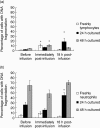Effect of medium/ω-6 long chain triglyceride-based emulsion on leucocyte death and inflammatory gene expression
- PMID: 21682721
- PMCID: PMC3170987
- DOI: 10.1111/j.1365-2249.2011.04432.x
Effect of medium/ω-6 long chain triglyceride-based emulsion on leucocyte death and inflammatory gene expression
Abstract
Lipid emulsion (LE) containing medium/ω-6 long chain triglyceride-based emulsion (MCT/ω-6 LCT LE) has been recommended in the place of ω-6 LCT-based emulsion to prevent impairment of immune function. The impact of MCT/ω-6 LCT LE on lymphocyte and neutrophil death and expression of genes related to inflammation was investigated. Seven volunteers were recruited and infusion of MCT/ω-6 LCT LE was performed for 6 h. Four volunteers received saline and no change was found. Blood samples were collected before, immediately afterwards and 18 h after LE infusion. Lymphocytes and neutrophils were studied immediately after isolation and after 24 and 48 h in culture. The following determinations were carried out: plasma-free fatty acids, triacylglycerol and cholesterol concentrations, plasma fatty acid composition, neutral lipid accumulation in lymphocytes and neutrophils, signs of lymphocyte and neutrophil death and lymphocyte expression of genes related to inflammation. MCT/ω-6 LCT LE induced lymphocyte and neutrophil death. The mechanism for MCT/ω-6 LCT LE-dependent induction of leucocyte death may involve changes in neutral lipid content and modulation of expression of genes related to cell death, proteolysis, cell signalling, inflammatory response, oxidative stress and transcription.
© 2011 The Authors. Clinical and Experimental Immunology © 2011 British Society for Immunology.
Figures





Similar articles
-
Human leukocyte death after a preoperative infusion of medium/long-chain triglyceride and fish oil parenteral emulsions: a randomized study in gastrointestinal cancer patients.JPEN J Parenter Enteral Nutr. 2012 Nov;36(6):677-84. doi: 10.1177/0148607111432759. Epub 2012 Jan 26. JPEN J Parenter Enteral Nutr. 2012. PMID: 22282868 Clinical Trial.
-
Effect of olive oil-based emulsion on human lymphocyte and neutrophil death.JPEN J Parenter Enteral Nutr. 2008 Jan-Feb;32(1):81-7. doi: 10.1177/014860710803200181. JPEN J Parenter Enteral Nutr. 2008. PMID: 18165452
-
Immune function and leukocyte sequestration under the influence of parenteral lipid emulsions in healthy humans: a placebo-controlled crossover study.Am J Clin Nutr. 2008 Mar;87(3):539-47. doi: 10.1093/ajcn/87.3.539. Am J Clin Nutr. 2008. PMID: 18326590 Clinical Trial.
-
Recent developments in lipid emulsions: relevance to intensive care.Nutrition. 1997 Sep;13(9 Suppl):73S-78S. doi: 10.1016/s0899-9007(97)00209-8. Nutrition. 1997. PMID: 9290113 Review.
-
Rapid enrichment of cell phospholipids in long-chain polyunsaturated ω-3 fatty acids after a bolus intravenous injection of a medium-chain triacylglycerol: fish oil emulsion in humans.JPEN J Parenter Enteral Nutr. 2012 Nov;36(6):671-6. doi: 10.1177/0148607112439211. Epub 2012 Mar 20. JPEN J Parenter Enteral Nutr. 2012. PMID: 22434201 Review.
Cited by
-
Intravenous anesthetic propofol suppresses T cell-dependent antibody production in mice.J Anesth. 2025 Jun 20. doi: 10.1007/s00540-025-03533-7. Online ahead of print. J Anesth. 2025. PMID: 40540032
-
Immunomodulation by an Omega-6 Fatty Acid Reduced Mixed Lipid Emulsion in Murine Acute Respiratory Distress Syndrome.J Clin Med. 2020 Jun 29;9(7):2048. doi: 10.3390/jcm9072048. J Clin Med. 2020. PMID: 32610690 Free PMC article.
-
Effects of lipid emulsions in parenteral nutrition of esophageal cancer surgical patients receiving enteral nutrition: a comparative analysis.Nutrients. 2013 Dec 27;6(1):111-23. doi: 10.3390/nu6010111. Nutrients. 2013. PMID: 24379010 Free PMC article. Clinical Trial.
References
-
- Calder PC. Rationale for using new lipid emulsions in parenteral nutrition and a review of the trials performed in adults. Proc Nutr Soc. 2009;68:252–60. - PubMed
-
- Wichmann MW, Thul P, Czarnetzki HD, Morlion BJ, Kemen M, Jauch KW. Evaluation of clinical safety and beneficial effects of a fish oil containing lipid emulsion (Lipoplus, MLF541): data from a prospective, randomized, multicenter trial. Crit Care Med. 2007;35:700–6. - PubMed
-
- Tsekos E, Reuter C, Stehle P, Boeden G. Perioperative administration of parenteral fish oil supplements in a routine clinical setting improves patient outcome after major abdominal surgery. Clin Nutr. 2004;23:325–30. - PubMed
-
- Freund U, Krausz Y, Levij IS, Eliakim M. Latrogenic lipidosis following prolonged intravenous hyperalimentation. Am J Clin Nutr. 1975;28:1156–60. - PubMed
Publication types
MeSH terms
Substances
LinkOut - more resources
Full Text Sources

